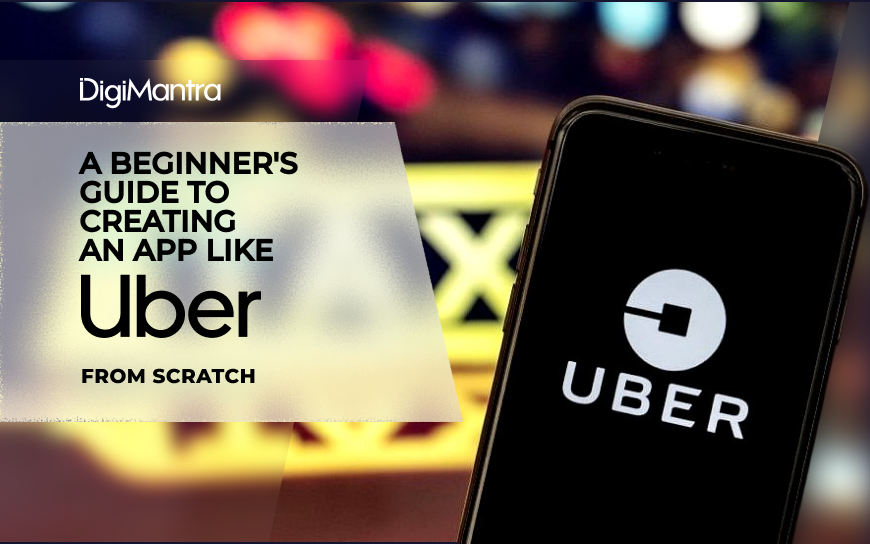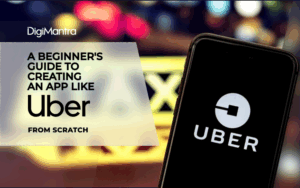The ride-hailing industry has gone through a dramatic makeover, turning everyday travel into an on-demand experience. According to Statista, this sector is projected to grow at a CAGR of 4.9% between 2025 and 2029, reaching an estimated market size of $212.8 billion by 2029. In the face of urban congestion and time-strapped commuters, on-demand taxi app development has become a must-have solution. Modern ridesharing apps make it easy to book a ride with just a tap, offering users a seamless travel experience enhanced by innovative features.
Uber stands as a prime example of how a ride-hailing platform can scale its operations to become a global giant. Over the years, it has transformed into a key player in the sharing economy, offering services beyond just transportation. As per a 2024 report by Statista, the platform now sees around 161 million monthly active users, which is a testament to its widespread adoption and continued growth.
If you're considering Uber like app development, studying Uber’s growth story can offer valuable insights. Success in this space hinges on recognizing the essential components of on-demand taxi app development and crafting solutions that directly address user challenges. This blog serves as a comprehensive guide to the essentials of taxi app development, with a focused look at current market trends, proven strategies, and widely used revenue models.
Key Takeaways from Uber’s Inspiring Growth Story
Did you know Uber has around 156 million people using its platform every month? That’s massive, and it’s no surprise the brand has become a benchmark in the global ride-hailing space. But Uber’s success didn’t happen overnight. Behind the scenes, the company followed smart processes and sharp strategies in its taxi application development that fueled its rise to the top.
For aspiring entrepreneurs looking to make their mark in the on-demand mobility space, Uber’s journey is packed with lessons. One standout approach has been its consistent use of the DMAIC framework, which is Define, Measure, Analyze, Improve, and Control, paired with a strong emphasis on user-centric design. These principles helped Uber not only build a robust product but also continuously optimize it to meet user needs in real-time.
At the heart of Uber’s success is its easy-to-use mobile app, designed for both riders and drivers, and available on both iOS and Android. Thanks to built-in geolocation in this ride hailing app development, users can instantly connect with nearby drivers, making the entire experience fast, smooth, and reliable.
To accommodate diverse customer expectations and spending levels, Uber offers multiple ride options:
- UberX - The budget-friendly choice for everyday commuters looking for a dependable and affordable ride.
- UberBLACK - A step up in style, this option offers premium vehicles and professional drivers for a more polished experience.
- UberSUV - Need extra space? UberSUV is perfect for larger groups or travelers with extra luggage, without sacrificing comfort.
- UberLUX - Designed for those who want the very best, UberLUX delivers top-of-the-line luxury cars and elite service for a truly VIP experience.
Uber’s flexible offerings make it a go-to choice for millions, be it your daily office commute or a special night out.

A Quick Look at How Taxi Apps Like Uber Make Money
Understanding the revenue model behind a taxi booking app like Uber gives you a clear picture of how the business stays profitable. Uber’s approach has become a go-to template for startups entering the ride-hailing space for taxi app development. It’s diverse, scalable, and proven to work.
Here are the main ways apps like Uber generate revenue:
- Commission gained from the driver
- Promotional partnerships
- In-app advertising
1. Commission Per Ride: The Core Revenue Stream
The primary way a taxi app like Uber generates income is through commissions taken from each completed ride. Every time a ride is booked and finished, a percentage of the fare goes to the platform. Since this revenue is tied directly to ride volume, it offers a steady and scalable income flow.
But that’s not all! Here are a few smart strategies that can further boost revenue:
- Subscription Plans
Offering tailored subscription models for both drivers and riders. Drivers could benefit from reduced commission fees, while riders might unlock perks like discounted fares or priority bookings, all for a recurring monthly fee.
- Surge Pricing
Dynamically adjusts fares based on real-time demand. When ride requests peak, like during rush hour or bad weather, prices rise, increasing overall earnings.
- Cancellation Fees
To reduce last-minute cancellations and cover driver inconvenience, users can be charged a small fee if they cancel after a certain time window.
- Wait Time Charges
If a rider delays beyond a preconfigured waiting period at the pickup point, a minute-based wait charge kicks in, reimbursing the driver and optimizing time efficiency.
2. Promotional Collaborations - Win-Win Brand Partnerships
An app like Uber boosts its revenue by partnering with big brands like Spotify, Pepsi, and Hilton. These collaborations allow Uber to promote branded content in-app, earning a fee while helping partners reach a wider audience.
In return, users often enjoy perks like discounts, coupons, or exclusive offers, making it a win for everyone involved.
3. In-App Advertising
Uber and Uber clone apps monetize their platforms through advertising and affiliate marketing. By promoting local businesses within the app, it earns revenue on a cost-per-click (CPC) or cost-per-mile (CPM) basis. This not only adds an extra income stream but also helps businesses connect with a highly targeted, active user base.

How Does the Uber App Work?
Uber’s ride-booking process is designed to be quick, simple, and user-friendly. In this system, the rider is the one booking the trip, and the driver is the one fulfilling it. Here’s a quick breakdown of how an app like Uber works:
- Request: The rider opens the app, sets a pickup location, and requests a ride. The request is instantly shared with nearby drivers.
- Matching: A driver in the vicinity can pick or skip the ride. If skipped, the request moves on to another available driver.
- Ride: Once a driver accepts, the rider receives confirmation along with the estimated arrival time and can track the vehicle in real time.
- Payment: The app shows the fare upfront. Riders can choose from multiple payment options, viz., card, wallet, or others, before or after the trip.
- Feedback: After the ride, riders can rate their experience and leave feedback, helping maintain service quality.

Steps Involved in Taxi Application Development
1. Start with In-Depth Market Research
Building an app like Uber begins with understanding your target audience and identifying their needs, preferences, and pain points. Here’s how to approach it:
- Analyze User Feedback: Study reviews and ratings of existing ride-hailing apps to discover what users love, and what they don’t.
- Identify User Challenges: Understand the daily hurdles your potential users face while commuting or using similar apps.
- Define Your USP: What will make your app stand out? Highlight the unique value your platform brings.
- Choose a Business Model: Will you rely on commissions, subscriptions, ads, or a mix of revenue streams?
- Solve Real Problems: Align your features and services with your audience’s expectations. Build a solution, not just an app.
- Map the Customer Journey: Create a visual flow of how users will interact with your app, from booking to payment to post-ride feedback.
- Study the Competition: See how your competitors market themselves, structure their services, and attract users.
- Understand Usage Patterns: Know when and how your users prefer to book rides, and tailor your offerings accordingly.
To organize your findings and guide the taxi application development process, document everything in a detailed product requirement or technical specification file.
Must-Have Features to Consider:
- Heat Maps for driver demand zones
- Panic Button for emergency situations
- Order Edit/Cancel Options
- Smart Analytics Dashboard
- Booking History & Saved Locations
- Multi-language Support for wider reach
Choosing the Right App Platform:
Your app can be native (built separately for iOS and Android) or hybrid (a single codebase for both), depending on the following factors:
- Target geographic region
- App development time & budget
- Feature complexity and performance expectations
If you're unsure, consulting with a professional taxi app development company can help you choose the ideal platform that aligns with your goals and budget.
2. Find the Right Uber-Like App Development Company
Start by choosing the region where you want to outsource development, keeping budget, expertise, and time zone in mind. Once you’ve hired a reliable digital transformation company, clearly share your app’s goals, challenges, and vision.
Effective communication ensures the team builds a tailored, high-quality solution that stands out in the market.
3. Crafting a Seamless User Journey with Suitable UI/UX Design
A well-designed UI/UX is key to delivering a smooth, intuitive experience for both riders and drivers. Your app should be visually appealing, easy to navigate, and built for quick actions like booking and tracking rides.
Focus on clean layouts, clear CTAs, and high usability while creating an app like Uber. To enhance the experience further, consider features like dark mode, smooth animations, accessibility options, and multilingual support to make the app both user-friendly and visually impressive.
4. Develop the App Using Agile Methodology
For taxi booking app development, following the agile development approach is highly effective. Agile is an iterative process where design, development, and testing happen in short, repeatable cycles.
New features are added and evaluated in each sprint, allowing for quick improvements and flexibility. With clearly defined milestones, the app evolves step-by-step, ensuring better quality and faster time-to-market.
5. Test, Market & Launch
Before launching your app like Uber, thorough testing is essential to ensure smooth performance, security, and feature stability. A dedicated QA team should test the app manually across multiple stages:
- Smoke Testing - Verifies core components are functioning.
- Functionality Testing - Checks all features work as expected.
- UI Testing - Ensures buttons, icons, and layouts look and behave correctly.
- Performance Testing - Measures speed, responsiveness, and overall usability.
Once testing of your taxi booking app development is complete, it’s time to plan your marketing strategy. Focus on app store optimization (ASO), digital campaigns, and pre-launch buzz. Use tactics like influencer partnerships, social media ads, and early-bird offers to drive downloads and user engagement.
After final QA approval, publish your app on the App Store and Google Play. A clean, well-tested launch sets the tone for the long-term success of an app like Uber.
Bottom Line

With soaring customer demand, the outlook for ride hailing app development looks incredibly optimistic. While creating an app like Uber requires time, investment, and ongoing improvements, the opportunity for new players to enter and thrive in this space is stronger than ever.
Now that you understand the steps to create a successful ride-hailing app, it's time to put those strategies into action. Despite the dominance of global players, there's plenty of room for evolution and growth.
If you’re ready to create your own taxi app, there’s no better time than now. DigiMantra is here to support your journey. We are a custom on-demand taxi booking app development company to help you scale and stand out in the competitive market.
Get in touch with us today to turn your ideas into reality.
Unlock Your Digital Potential Today!
Don’t just keep up, lead your industry.
Connect with DigiMantra’s top strategists and AI, web, and software experts to boost growth, streamline operations, and drive innovation.
Your transformation starts here.





